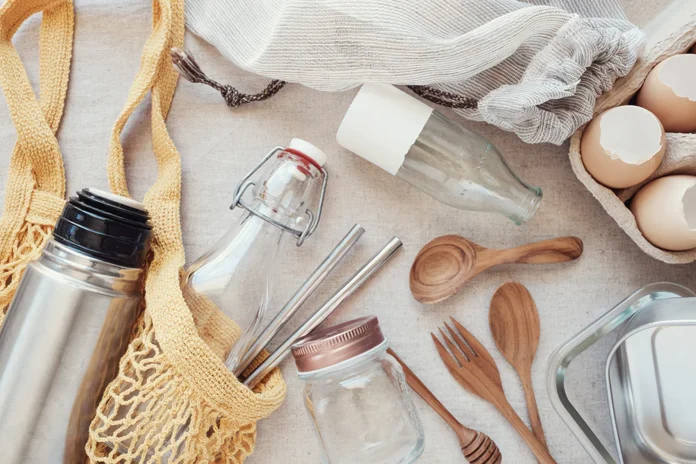If you’re working towards creating an eco-friendly home, you may be figuring out how to reduce your use of single-use plastic. From convenience to cost, it’s easy to default to plastic-based items when shopping and stocking your kitchen. But with a few simple changes, you can significantly reduce your reliance on single-use plastic while still keeping life as convenient and comfortable as possible. Sustainability expert Vikki Gerrard La Crosse WI shares tips for creating a plastic-free home.
Start In The Kitchen
The kitchen is often the biggest user of plastic in our homes, so it’s a great place to start making changes. Investing in reusable storage containers, jars and bags can help you reduce your reliance on single-use plastics like Ziplocs or disposable Tupperware. When possible, opt for glass or stainless steel containers with lids that can be washed and reused.
While many areas have already banned plastic shopping bags, switching to reusable ones can significantly decrease the amount of plastic that enters your home. When shopping for groceries, bring your reusable bags for loading groceries. Certain items like fruits, vegetables, and bulk items like grains, nuts, and spices can often be purchased without packaging – reducing plastic waste even more.
Plastic straws have become one of the top sources of single-use plastics, so look for alternatives to disposable items like plastic utensils, cups, plates, and water bottles. You can also buy food in jars or cans instead of plastic packaging. And when shopping for fresh meat or seafood, ask the butcher not to put them in a plastic bag.
It’s also a good idea to invest in reusable beeswax wraps or silicone lids as an alternative to plastic wrap. You can make your cloth produce bags for items like apples, nuts, and grains. Switch from disposable sponges and paper towels to washable cloths for cleaning up after meals. You can also make reusable cleaning wipes from upcycled materials like old t-shirts.
In The Bathroom
Your bathroom is another spot where you can reduce your reliance on plastic. Instead of purchasing items in single-use containers, opt for refillable or concentrated versions of products like shampoo and laundry detergent. You can also switch from using disposable razors to reusable safety razors.
Rather than buying plastic toothbrushes, opt for bamboo or stainless steel models that are biodegradable and can be reused over time. And instead of reaching for single-use cotton swabs, invest in a set of reusable ear wax removers which can be cleaned and reused. Washable cotton rounds can keep your skin clean and sanitary without using single-use make-up wipes.
Another way to reduce plastic waste in the bathroom is to switch from purchasing individual items like shampoo, conditioner, and body wash in single-use containers. Many liquid hygiene products, like shampoo and conditioner, can also be purchased as solids in tins or made from home.
In The Bedroom
Vikki Gerrard La Crosse WI understands that it’s easy to overlook the bedroom when it comes to plastic reduction, but there are still a few ways to make changes. Instead of single-use hangers for your clothes, opt for wooden or metal models that can be used repeatedly. You can also switch from using plastic laundry baskets to a wicker or cloth basket.
When it comes time to buy new sheets and bedding, look for materials like cotton, linen or bamboo which are more sustainable fabrics. And don’t forget about the mattress – opt for a natural latex mattress instead of a traditional spring model which is usually made with petroleum-based foam.
Plastics can also be eliminated from bedrooms by switching from plastic lamps to metal or wood models. You can also find non-plastic alternatives for items like toys, books, and games which are often made with plastic. By switching out these items, you’ll also add unique textures and character to your space while reducing plastic waste.
Other Areas Of The Home
Small changes around the home can go a long way when it comes to reducing plastic waste. Reusable straws and utensils are easy options for everyday items that can replace single-use plastic alternatives. You can also look for other non-plastic items like cutlery, dishes and glassware that can last for years.
Pantry items like coffee, tea, and spices can be purchased in bulk bins or even made from scratch to avoid excess plastic packaging. And when it comes time to buy new furniture, look for models made from FSC-certified wood or recycled upholstery.
Final Thoughts
Creating a plastic-free home doesn’t have to be overwhelming or expensive. Small changes, like switching from single-use items to reusable options and investing in refillable products, can help reduce the amount of plastic entering your home. As you make the switch, you’ll see the benefits in your wallet and our environment. By taking these steps recommended by Vikki Gerrard La Crosse WI, you and your family can help reduce plastic waste and positively impact the planet. With just a few simple swaps, everyone can do their part in making the world more sustainable.












